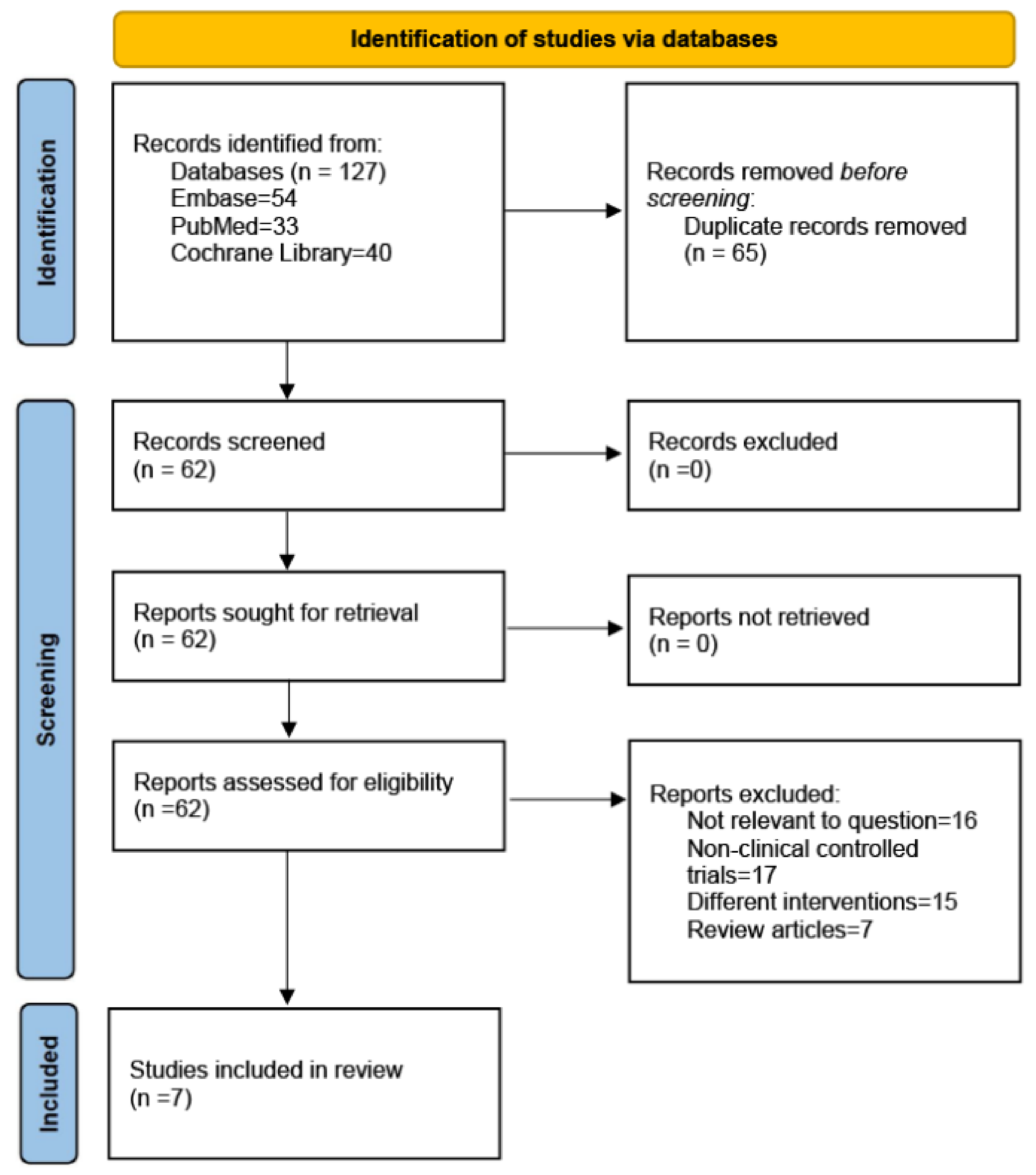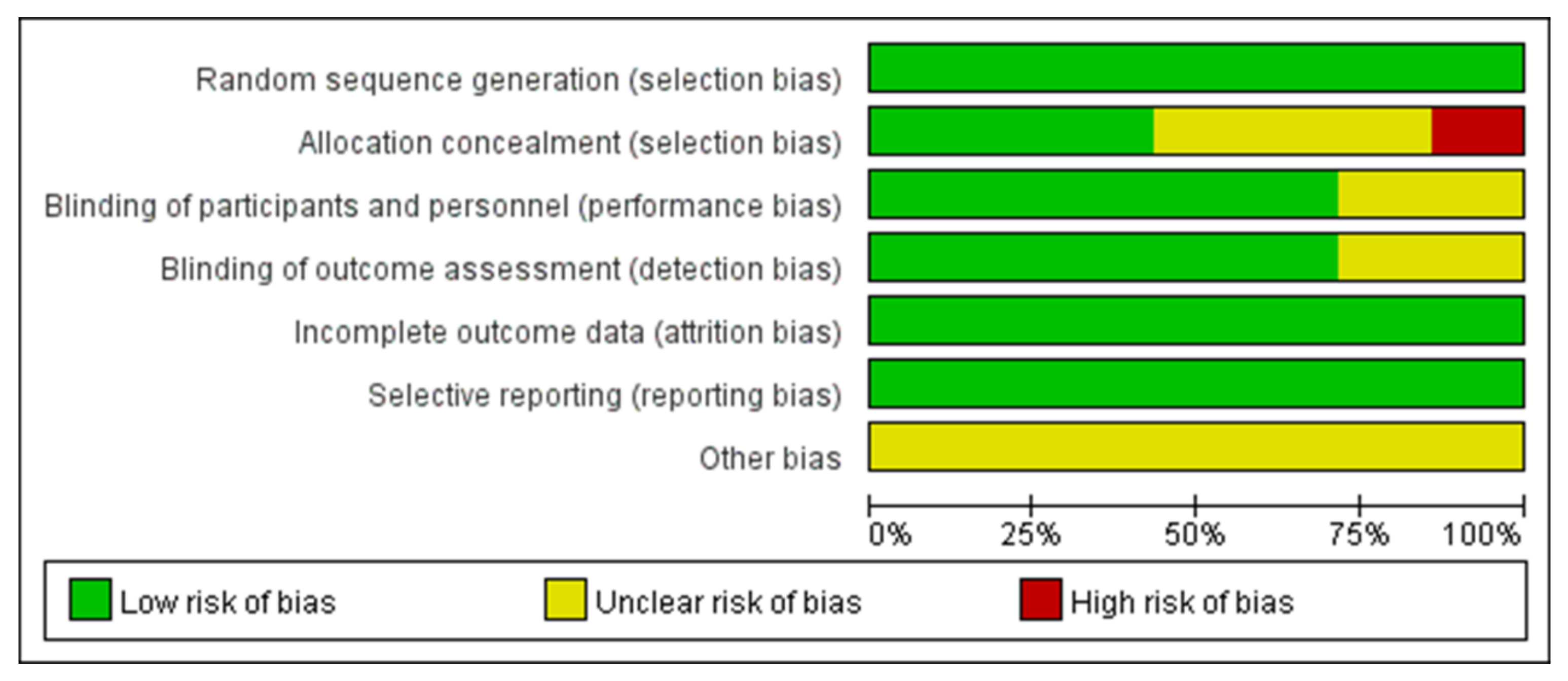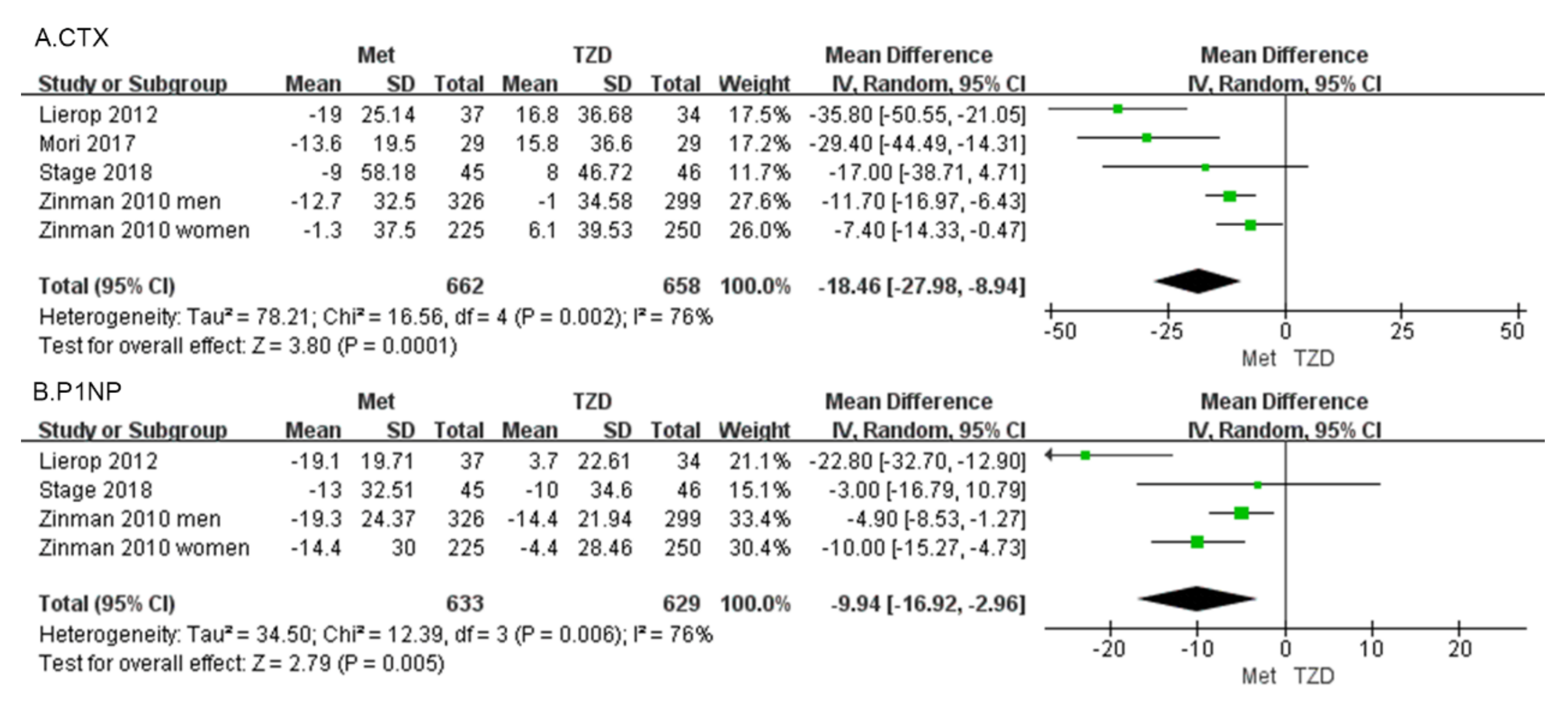Comparison of the Effects of Metformin and Thiazolidinediones on Bone Metabolism: A Systematic Review and Meta-Analysis
Abstract
:1. Introduction
2. Materials and Methods
2.1. Search Strategy
2.2. Inclusion and Exclusion Criteria
2.2.1. Participants
2.2.2. Interventions and Exposures
- 1.
- Clinical intervention trials comparing thiazolidinediones and metformin.
- 2.
- Combined insulin for blood glucose control.
2.2.3. Study Types
2.3. Outcomes
2.4. Data Extraction
2.5. Risk of Bias and Quality Assessment
2.6. Statistical Analysis and Assessment of Publication Bias
3. Results
3.1. Search Results
3.2. Primary Outcomes
3.2.1. Changes in BMD
3.2.2. Changes in BTMs
3.2.3. Secondary Outcomes
4. Discussion
5. Conclusions
Supplementary Materials
Author Contributions
Funding
Institutional Review Board Statement
Informed Consent Statement
Data Availability Statement
Acknowledgments
Conflicts of Interest
Abbreviations
References
- Rubin, M.R.; Patsch, J.M. Assessment of bone turnover and bone quality in type 2 diabetic bone disease: Current concepts and future directions. Bone Res. 2016, 4, 16001. [Google Scholar] [CrossRef] [PubMed]
- Wang, H.; Ba, Y.; Xing, Q.; Du, J.L. Diabetes mellitus and the risk of fractures at specific sites: A meta-analysis. BMJ Open 2019, 9, e024067. [Google Scholar] [CrossRef] [PubMed]
- Bahrambeigi, S.; Yousefi, B.; Rahimi, M.; Shafiei-Irannejad, V. Metformin: An old antidiabetic drug with new potentials in bone disorders. Biomed. Pharmacother. 2019, 109, 1593–1601. [Google Scholar] [CrossRef] [PubMed]
- Schwartz, A.V. Diabetes, bone and glucose-lowering agents: Clinical outcomes. Diabetologia 2017, 60, 1170–1179. [Google Scholar] [CrossRef]
- Cortet, B.; Lucas, S.; Legroux-Gerot, I.; Penel, G.; Chauveau, C.; Paccou, J. Bone disorders associated with diabetes mellitus and its treatments. Jt. Bone Spine 2019, 86, 315–320. [Google Scholar] [CrossRef]
- Hofbauer, L.C.; Busse, B.; Eastell, R.; Ferrari, S.; Frost, M.; Müller, R.; Burden, A.M.; Rivadeneira, F.; Napoli, N.; Rauner, M. Bone fragility in diabetes: Novel concepts and clinical implications. Lancet. Diabetes Endocrinol. 2022, 10, 207–220. [Google Scholar] [CrossRef]
- Li, Y.; Wang, L.; Zhang, M.; Huang, K.; Yao, Z.; Rao, P.; Cai, X.; Xiao, J. Advanced glycation end products inhibit the osteogenic differentiation potential of adipose-derived stem cells by modulating Wnt/β-catenin signalling pathway via DNA methylation. Cell Prolif. 2020, 53, e12834. [Google Scholar] [CrossRef]
- Jackuliak, P.; Kužma, M.; Payer, J. Effect of antidiabetic treatment on bone. Physiol. Res. 2019, 68, S107–S120. [Google Scholar] [CrossRef]
- Meier, C.; Schwartz, A.V.; Egger, A.; Lecka-Czernik, B. Effects of diabetes drugs on the skeleton. Bone 2016, 82, 93–100. [Google Scholar] [CrossRef]
- Antonopoulou, M.; Bahtiyar, G.; Banerji, M.A.; Sacerdote, A.S. Diabetes and bone health. Maturitas 2013, 76, 253–259. [Google Scholar] [CrossRef]
- Billington, E.O.; Grey, A.; Bolland, M.J. The effect of thiazolidinediones on bone mineral density and bone turnover: Systematic review and meta-analysis. Diabetologia 2015, 58, 2238–2246. [Google Scholar] [CrossRef] [PubMed]
- Zhu, Z.-N.; Jiang, Y.-F.; Ding, T. Risk of fracture with thiazolidinediones: An updated meta-analysis of randomized clinical trials. Bone 2014, 68, 115–123. [Google Scholar] [CrossRef] [PubMed]
- Ng, K.W. Regulation of glucose metabolism and the skeleton. Clin. Endocrinol. 2011, 75, 147–155. [Google Scholar] [CrossRef]
- Kalaitzoglou, E.; Fowlkes, J.L.; Popescu, I.; Thrailkill, K.M. Diabetes pharmacotherapy and effects on the musculoskeletal system. Diabetes/Metab. Res. Rev. 2019, 35, e3100. [Google Scholar] [CrossRef]
- Cortizo, A.M.; Sedlinsky, C.; McCarthy, A.D.; Blanco, A.; Schurman, L. Osteogenic actions of the anti-diabetic drug metformin on osteoblasts in culture. Eur. J. Pharmacol. 2006, 536, 38–46. [Google Scholar] [CrossRef] [PubMed]
- Kanazawa, I.; Yamaguchi, T.; Yano, S.; Yamauchi, M.; Sugimoto, T. Metformin enhances the differentiation and mineralization of osteoblastic MC3T3-E1 cells via AMP kinase activation as well as eNOS and BMP-2 expression. Biochem. Biophys. Res. Commun. 2008, 375, 414–419. [Google Scholar] [CrossRef]
- Hegazy, S.K. Evaluation of the anti-osteoporotic effects of metformin and sitagliptin in postmenopausal diabetic women. J. Bone Miner. Metab. 2015, 33, 207–212. [Google Scholar] [CrossRef] [PubMed]
- Hidayat, K.; Du, X.; Wu, M.J.; Shi, B.M. The use of metformin, insulin, sulphonylureas, and thiazolidinediones and the risk of fracture: Systematic review and meta-analysis of observational studies. Obes. Rev. 2019, 20, 1494–1503. [Google Scholar] [CrossRef]
- Williams, C.; Sapra, A. Osteoporosis Markers; StatPearls Publishing: Treasure Island, FL, USA, 2020. [Google Scholar]
- Johnell, O.; Odén, A.; De Laet, C.; Garnero, P.; Delmas, P.; Kanis, J.A. Biochemical indices of bone turnover and the assessment of fracture probability. Osteoporos. Int. 2002, 13, 523. [Google Scholar] [CrossRef]
- Cavalier, E.; Lukas, P.; Bottani, M.; Aarsand, A.; Ceriotti, F.; Coşkun, A.; Díaz-Garzón, J.; Fernàndez-Calle, P.; Guerra, E.; Locatelli, M.; et al. European Biological Variation Study (EuBIVAS): Within-and between-subject biological variation estimates of β-isomerized C-terminal telopeptide of type I collagen (β-CTX), N-terminal propeptide of type I collagen (PINP), osteocalcin, intact fibroblast growth factor 23 and uncarboxylated-unphosphorylated matrix-Gla protein—A cooperation between the EFLM Working Group on Biological Variation and the International Osteoporosis Foundation-International Federation of Clinical Chemistry Committee on Bone Metabolism. Osteoporos. Int. 2020, 31, 1461–1470. [Google Scholar]
- Szulc, P.; Naylor, K.; Hoyle, N.; Eastell, R.; Leary, E.T.; National Bone Health Alliance Bone Turnover Marker Project. Use of CTX-I and PINP as bone turnover markers: National Bone Health Alliance recommendations to standardize sample handling and patient preparation to reduce pre-analytical variability. Osteoporos. Int. 2017, 28, 2541–2556. [Google Scholar] [CrossRef] [PubMed]
- Glendenning, P.; Chubb, S.P.; Vasikaran, S. Clinical utility of bone turnover markers in the management of common metabolic bone diseases in adults. Clin. Chim. Acta 2018, 481, 161–170. [Google Scholar] [CrossRef] [PubMed]
- Moher, D.; Liberati, A.; Tetzlaff, J.; Altman, D.G.; PRISMA Group. Preferred reporting items for systematic reviews and meta-analyses: The PRISMA statement. Ann. Intern. Med. 2009, 151, 264–269. [Google Scholar] [CrossRef] [PubMed]
- Page, M.J.; McKenzie, J.E.; Bossuyt, P.M.; Boutron, I.; Hoffmann, T.C.; Mulrow, C.D.; Shamseer, L.; Tetzlaff, J.M.; Akl, E.A.; Brennan, S.E. The PRISMA 2020 statement: An updated guideline for reporting systematic reviews. Int. J. Surg. 2021, 88, 105906. [Google Scholar] [CrossRef] [PubMed]
- Yang, C.-W.; Kuang, M.; Chen, R.-D.; Zhu, Q.-R.; Han, S.-J.; Kuang, M.-J. Efficacy of umbilical cord mesenchymal stromal cells for COVID-19: A systematic review and meta-analysis. Front. Immunol. 2022, 13, 4804. [Google Scholar] [CrossRef]
- Higgins, J.P.; Thomas, J.; Chandler, J.; Cumpston, M.; Li, T.; Page, M.J.; Welch, V.A. Cochrane Handbook for Systematic Reviews of Interventions; John Wiley & Sons: Hoboken, NJ, USA, 2019. [Google Scholar]
- Faggion, C.M., Jr. Evaluating the Risk of Bias of a Study. J. Evid. Based Dent. Pract. 2015, 15, 164–170. [Google Scholar] [CrossRef]
- Bilezikian, J.P.; Josse, R.G.; Eastell, R.; Lewiecki, E.M.; Miller, C.G.; Wooddell, M.; Northcutt, A.R.; Kravitz, B.G.; Paul, G.; Cobitz, A.R.; et al. Rosiglitazone decreases bone mineral density and increases bone turnover in postmenopausal women with type 2 diabetes mellitus. J. Clin. Endocrinol. Metab. 2013, 98, 1519–1528. [Google Scholar] [CrossRef]
- Zinman, B.; Haffner, S.M.; Herman, W.H.; Holman, R.R.; Lachin, J.M.; Kravitz, B.G.; Paul, G.; Jones, N.P.; Aftring, R.P.; Viberti, G.; et al. Effect of rosiglitazone, metformin, and glyburide on bone biomarkers in patients with type 2 diabetes. J. Clin. Endocrinol. Metab. 2010, 95, 134–142. [Google Scholar] [CrossRef]
- Van Lierop, A.H.; Hamdy, N.A.; van der Meer, R.W.; Jonker, J.T.; Lamb, H.J.; Rijzewijk, L.J.; Diamant, M.; Romijn, J.A.; Smit, J.W.; Papapoulos, S.E. Distinct effects of pioglitazone and metformin on circulating sclerostin and biochemical markers of bone turnover in men with type 2 diabetes mellitus. Eur. J. Endocrinol. 2012, 166, 711–716. [Google Scholar] [CrossRef]
- Miller, C.G.; Bogado, C.C.; Nino, A.J.; Northcutt, A.R.; Yu, H.J.; Lewiecki, E.M.; Paul, G.; Cobitz, A.R.; Wooddell, M.J.; Bilezikian, J.P.; et al. Evaluation of Quantitative Computed Tomography Cortical Hip Quadrant in a Clinical Trial With Rosiglitazone: A Potential New Study Endpoint. J. Clin. Densitom. 2016, 19, 485–491. [Google Scholar] [CrossRef]
- Stage, T.B.; Christensen, M.H.; Jørgensen, N.R.; Beck-Nielsen, H.; Brøsen, K.; Gram, J.; Frost, M. Effects of metformin, rosiglitazone and insulin on bone metabolism in patients with type 2 diabetes. Bone 2018, 112, 35–41. [Google Scholar] [CrossRef] [PubMed]
- Mori, H.; Okada, Y.; Tanaka, Y. The Effects of Pioglitazone on Bone Formation and Resorption Markers in Type 2 Diabetes Mellitus. Intern. Med. 2017, 56, 1301–1306. [Google Scholar] [CrossRef] [PubMed]
- Kanazawa, I.; Yamaguchi, T.; Yano, S.; Yamamoto, M.; Yamauchi, M.; Kurioka, S.; Sugimoto, T. Baseline atherosclerosis parameter could assess the risk of bone loss during pioglitazone treatment in type 2 diabetes mellitus. Osteoporos. Int. 2010, 21, 2013–2018. [Google Scholar] [CrossRef]
- Deeks, J.J.; Higgins, J.P.; Altman, D.G. Analysing data and undertaking meta-analyses. In Cochrane Handbook for Systematic Reviews of Interventions, 2nd ed.; Higgins, J.P., Thomas, J., Chandler, J., Cumpston, M., Li, T., Page, M.J., Welch, V.A., Eds.; The Cochrane Collaboration: London, UK, 2019; pp. 241–284. [Google Scholar]
- Tseng, C.H. Metformin use is associated with a lower risk of osteoporosis/vertebral fracture in Taiwanese patients with type 2 diabetes mellitus. Eur. J. Endocrinol. 2021, 184, 299–310. [Google Scholar] [CrossRef] [PubMed]
- Salari-Moghaddam, A.; Sadeghi, O.; Keshteli, A.H.; Larijani, B.; Esmaillzadeh, A. Metformin use and risk of fracture: A systematic review and meta-analysis of observational studies. Osteoporos. Int. 2019, 30, 1167–1173. [Google Scholar] [CrossRef]
- Oh, T.K.; Song, I.-A. Metformin therapy and hip fracture risk among patients with type II diabetes mellitus: A population-based cohort study. Bone 2020, 135, 115325. [Google Scholar] [CrossRef]
- Vasikaran, S.; Cooper, C.; Eastell, R.; Griesmacher, A.; Morris, H.A.; Trenti, T.; Kanis, J.A. International Osteoporosis Foundation and International Federation of Clinical Chemistry and Laboratory Medicine position on bone marker standards in osteoporosis. Clin. Chem. Lab. Med. 2011, 49, 1271–1274. [Google Scholar] [CrossRef]
- Lazarenko, O.P.; Rzonca, S.O.; Hogue, W.R.; Swain, F.L.; Suva, L.J.; Lecka-Czernik, B. Rosiglitazone induces decreases in bone mass and strength that are reminiscent of aged bone. Endocrinology 2007, 148, 2669–2680. [Google Scholar] [CrossRef]
- Chubb, S.P. Measurement of C-terminal telopeptide of type I collagen (CTX) in serum. Clin. Biochem. 2012, 45, 928–935. [Google Scholar] [CrossRef]
- Naylor, K.; Eastell, R. Bone turnover markers: Use in osteoporosis. Nat. Rev. Rheumatol. 2012, 8, 379–389. [Google Scholar] [CrossRef]
- Mai, Q.G.; Zhang, Z.M.; Xu, S.; Lu, M.; Zhou, R.P.; Zhao, L.; Jia, C.H.; Wen, Z.H.; Jin, D.D.; Bai, X.C. Metformin stimulates osteoprotegerin and reduces RANKL expression in osteoblasts and ovariectomized rats. J. Cell. Biochem. 2011, 112, 2902–2909. [Google Scholar] [CrossRef] [PubMed]
- Jang, W.G.; Kim, E.J.; Bae, I.H.; Lee, K.N.; Kim, Y.D.; Kim, D.K.; Kim, S.H.; Lee, C.H.; Franceschi, R.T.; Choi, H.S.; et al. Metformin induces osteoblast differentiation via orphan nuclear receptor SHP-mediated transactivation of Runx2. Bone 2011, 48, 885–893. [Google Scholar] [CrossRef] [PubMed]
- Nishizawa, Y.; Ohta, H.; Miura, M.; Inaba, M.; Ichimura, S.; Shiraki, M.; Takada, J.; Chaki, O.; Hagino, H.; Fujiwara, S.; et al. Guidelines for the use of bone metabolic markers in the diagnosis and treatment of osteoporosis (2012 edition). J. Bone Miner. Metab. 2013, 31, 1–15. [Google Scholar] [CrossRef] [PubMed]
- Wolverton, D.; Blair, M.M. Fracture risk associated with common medications used in treating type 2 diabetes mellitus. Am. J. Health-Syst. Pharm. 2017, 74, 1143–1151. [Google Scholar] [CrossRef] [PubMed]
- Aubert, R.; Herrera, V.; Chen, W.; Haffner, S.; Pendergrass, M. Rosiglitazone and pioglitazone increase fracture risk in women and men with type 2 diabetes. Diabetes Obes. Metab. 2010, 12, 716–721. [Google Scholar] [CrossRef] [PubMed]
- Zhou, G.; Myers, R.; Li, Y.; Chen, Y.; Shen, X.; Fenyk-Melody, J.; Wu, M.; Ventre, J.; Doebber, T.; Fujii, N.; et al. Role of AMP-activated protein kinase in mechanism of metformin action. J. Clin. Investig. 2001, 108, 1167–1174. [Google Scholar] [CrossRef]
- Fryer, L.G.; Parbu-Patel, A.; Carling, D. The Anti-diabetic drugs rosiglitazone and metformin stimulate AMP-activated protein kinase through distinct signaling pathways. J. Biol. Chem. 2002, 277, 25226–25232. [Google Scholar] [CrossRef]
- Jeyabalan, J.; Viollet, B.; Smitham, P.; Ellis, S.; Zaman, G.; Bardin, C.; Goodship, A.; Roux, J.; Pierre, M.; Chenu, C. The anti-diabetic drug metformin does not affect bone mass in vivo or fracture healing. Osteoporos. Int. 2013, 24, 2659–2670. [Google Scholar] [CrossRef]
- Brown, J.P.; Don-Wauchope, A.; Douville, P.; Albert, C.; Vasikaran, S.D. Current use of bone turnover markers in the management of osteoporosis. Clin. Biochem. 2022, 109–110, 1–10. [Google Scholar] [CrossRef]





| Study | Year | Country | Sample Met/TZD | Age Met/TZD | Gender Women% | BMI (kg/m2) Met/TZD | Intervention | Daily Dose Met/TZD | Patients | Observed Duration | Study Design |
|---|---|---|---|---|---|---|---|---|---|---|---|
| Zinman | 2010 [30] | America and Europe | 551/549 | 56.6 ± 9.4/ 56.9 ± 10.0 | 40.8%/ 45.5% | 32.8 ± 6.1/ 32.5 ± 6.5 | Met/ Rosiglitazone | 2 g/8 mg | T2DM | 12 Months | RCT |
| Lierop | 2012 [31] | The Netherlands | 37/34 | 56.5 ± 5.4/ 56.4 ± 5.9 | 0% | 29.3 ± 3.8/ 28.2 ± 3.0 | Met/ Pioglitazone | 1 g/15 mg | T2DM | 24 Weeks | RCT |
| Miller | 2016 [32] | USA | 34/32 | 55.0 ± 16.4/ 56.5 ± 5.6 | 100% | 25.4 ± 4.0/ 28.7 ± 3.4 | Met/Rosiglitazone | 2 g/8 mg | T2DM | 76 Weeks | RCT |
| Stage | 2017 [33] | Denmark | 45/46 | 57 | 38% | 34.6 | Met/Rosiglitazone | 1 g/8 mg | T2DM | 24 Weeks | RCT |
| Mori | 2017 [34] | Japan | 29/29 | 65.1 ± 7.7/ 64.1 ± 8.5 | 55.17%/ 62.07% | 24.3 ± 3.8/25.6 ± 4.0 | Met/Pioglitazone | 750 mg/ 15 or 30 mg | T1DM | 3 Months | RCT |
| Kanazawa | 2009 [35] | Japan | 23/22 | 66 ± 10/ 67 ± 10 | 43.5%/ 36.3% | 24.9 ± 3.7/22.0 ± 2.3 | Met/Pioglitazone | 500–750 mg/15–30 mg | T2DM | 3 Months | RCT |
| Bilezikian | 2012 [29] | USA | 111/114 | 64.0 ± 6.46/ 63.6 ± 6.61 | 100% | 31.5 ± 5.79/ 31.2 ± 5.86 | Met/Rosiglitazone | 2g/8 mg | T2DM | 76 Weeks | RCT |
Disclaimer/Publisher’s Note: The statements, opinions and data contained in all publications are solely those of the individual author(s) and contributor(s) and not of MDPI and/or the editor(s). MDPI and/or the editor(s) disclaim responsibility for any injury to people or property resulting from any ideas, methods, instructions or products referred to in the content. |
© 2023 by the authors. Licensee MDPI, Basel, Switzerland. This article is an open access article distributed under the terms and conditions of the Creative Commons Attribution (CC BY) license (https://creativecommons.org/licenses/by/4.0/).
Share and Cite
Chen, R.-D.; Yang, C.-W.; Zhu, Q.-R.; Li, Y.; Hu, H.-F.; Wang, D.-C.; Han, S.-J. Comparison of the Effects of Metformin and Thiazolidinediones on Bone Metabolism: A Systematic Review and Meta-Analysis. Medicina 2023, 59, 904. https://doi.org/10.3390/medicina59050904
Chen R-D, Yang C-W, Zhu Q-R, Li Y, Hu H-F, Wang D-C, Han S-J. Comparison of the Effects of Metformin and Thiazolidinediones on Bone Metabolism: A Systematic Review and Meta-Analysis. Medicina. 2023; 59(5):904. https://doi.org/10.3390/medicina59050904
Chicago/Turabian StyleChen, Ru-Dong, Cong-Wen Yang, Qing-Run Zhu, Yu Li, Hai-Feng Hu, Da-Chuan Wang, and Shi-Jie Han. 2023. "Comparison of the Effects of Metformin and Thiazolidinediones on Bone Metabolism: A Systematic Review and Meta-Analysis" Medicina 59, no. 5: 904. https://doi.org/10.3390/medicina59050904
APA StyleChen, R.-D., Yang, C.-W., Zhu, Q.-R., Li, Y., Hu, H.-F., Wang, D.-C., & Han, S.-J. (2023). Comparison of the Effects of Metformin and Thiazolidinediones on Bone Metabolism: A Systematic Review and Meta-Analysis. Medicina, 59(5), 904. https://doi.org/10.3390/medicina59050904








